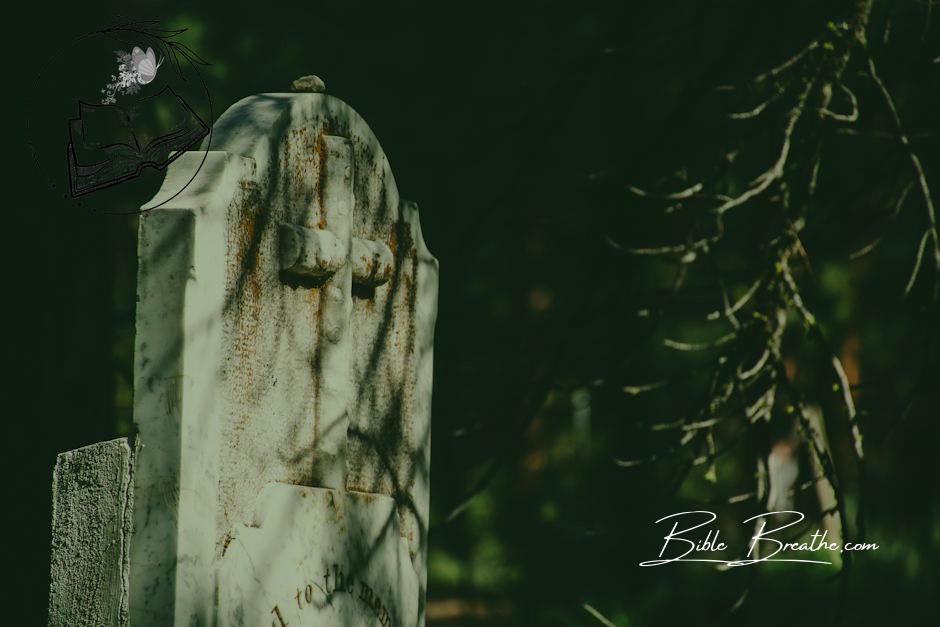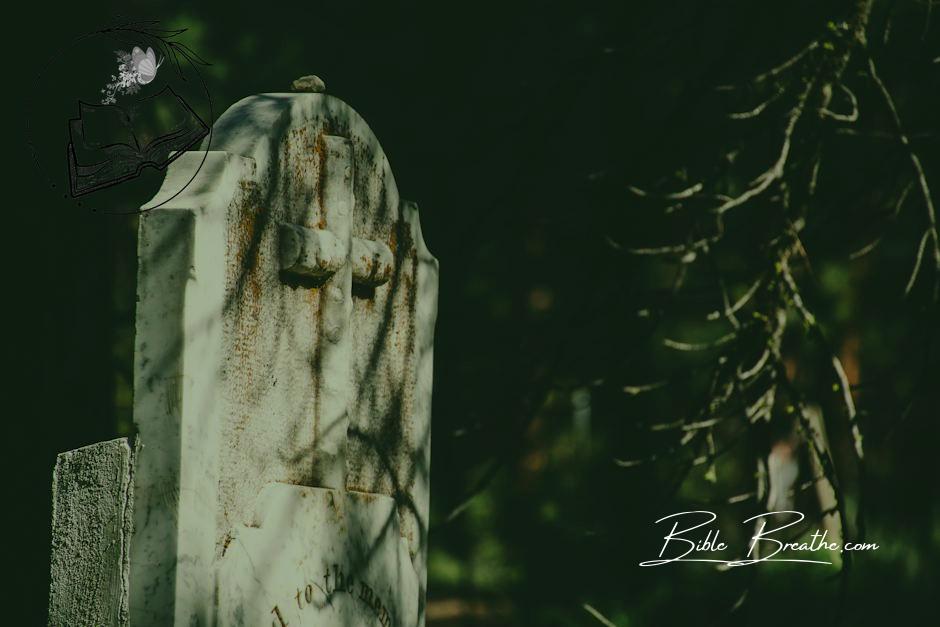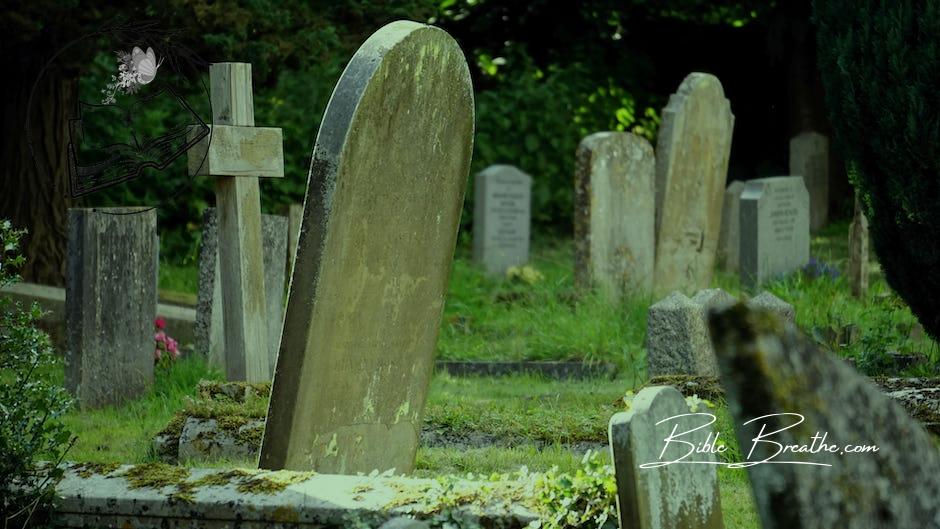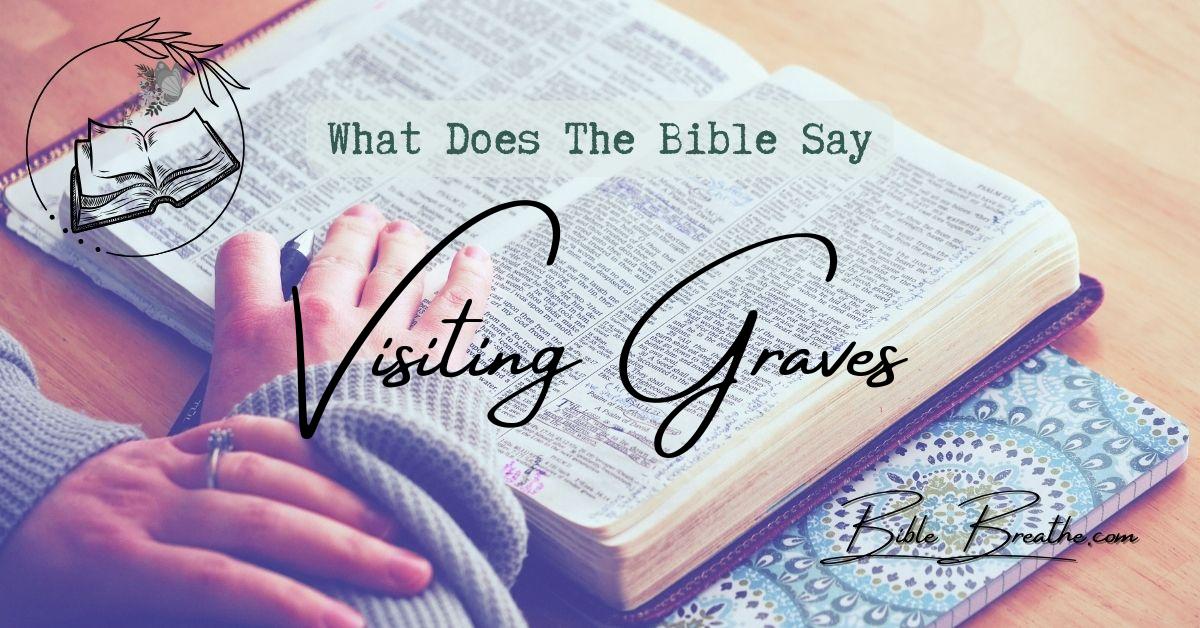Key Takeaways
- So, what does the Bible say about visiting graves? It’s more than a physical act; it carries profound spiritual implications.
- Amidst the gravestones, find solace in the hope and comfort the Bible offers through the concept of resurrection. It’s a beacon for believers, promising life beyond the earthly confines.
- The Bible encourages us to mourn, but not without hope and faith. The act of visiting graves becomes a way to express grief while holding on to the assurance of eternal life.
- In the midst of grief, there’s a call to reflect on the profound biblical truths surrounding life, death, and the resilience of faith.
Introduction – Ever thought about what the Bible says on visiting graves?
It’s like digging into a treasure chest of ancient wisdom!
Back in biblical days, visiting graves wasn’t just a nod to the past; it was a deep spiritual connection.
Think of tombstones as more than stones – they’re symbols of love and faith.
But hold on, there’s more!
Grave visits are like a spiritual GPS, guiding us through the journey of life and death.
Remember Lazarus?
He went from the tomb to life in a jaw-dropping moment.
That’s not just a story; it’s a lesson in hope and resurrection.
In our talk today, we’ll unravel the secrets of biblical mourning, explore burial customs, and dive into the eternal mysteries hidden within.
Join us on this epic quest through the Bible – it’s a journey of life, death, and the promise of something beyond.
Ready to dive in? 🌟
Visiting Graves in the Bible: Unveiling Spiritual Connections

Photo modified by BibleBreathe.com. Original photo by Brett Sayles on Pexels
Hey there, fam!
Today, we’re diving into a topic that’s not just biblical but deeply personal and spiritually profound – visiting graves.
Now, I know it might sound like a heavy topic, but trust me, it’s all about finding hope and faith even in the midst of grief and loss.
The Commonality of Visiting Graves during Biblical Times
Alright, picture this: you’re in the heart of biblical history.
People back then were all about their faith, and visiting graves was as common as sending a text today.
It was a way to remember, reflect, and find solace.
Now, let me drop some knowledge.
Remember when Lazarus bit the dust and then was brought back to life by Jesus?
That’s more than a miracle, folks; it’s a testament to the power of visiting graves.
The grave was a place of sorrow, but it also became a place of hope and joy.
You see, when we visit graves today, it’s not much different from those biblical times.
It’s about remembering our loved ones, finding closure, and connecting with something much bigger than ourselves.
It’s a moment to hit pause and reflect on life, death, and the road to salvation.
Personal Experiences and Revelations during Graveyard Visits
Now, let’s fast forward to today.
When we visit graves, it’s not just a ritual; it’s personal.
Just like the folks in the Bible, we can have some powerful spiritual moments at the cemetery.
Imagine this: you’re standing by a tombstone, running your fingers over the words etched into it, telling the story of a life.
In those quiet moments, you might feel a connection to something greater than yourself.
It’s in those moments that our faith and hope often shine the brightest.
The Bible is full of stories of folks who had these profound encounters at graves, and you can too.
The grave is a place where faith and the tangible world collide.
It’s where we face the reality of death but also hold onto the hope of resurrection.
When you visit a grave, you’re not just paying respects; you’re connecting with something eternal.
So, when you’re at a gravesite, remember you’re a part of a tradition that goes way back.
It’s an opportunity to dive deep into your faith, find hope, and connect with the spiritual, just like our biblical heroes did.
I am the resurrection, and the life: he that believeth in me, though he were dead, yet shall he live.” – John 11:25 (KJV)
Keep the faith, fam!
💪🙏
Unpacking Biblical Insights on Grave Visits: A Word from PASTOR MICHAEL TODD

Photo modified by BibleBreathe.com. Original photo by Brett Sayles on Pexels
Hey there, family!
Today, we’re delving into the Word, unlocking the powerful stories of those who stood by graves and witnessed God’s miraculous touch, unveiling hope, and defeating the grip of death.
The Three Women and Jesus’ Tomb
Picture this: a sunrise that changed everything.
On Easter morn, three courageous women headed to Jesus’ resting place, hearts heavy with sorrow.
Yet, within their grieving hearts lay a spark of hope.
As they arrived, they found the stone rolled away, an empty tomb—proof that our Savior had risen, shattering the chains of death and offering us eternal salvation.
“He is not here: for he is risen, as he said. Come, see the place where the Lord lay.” – Matthew 28:6 (KJV)
The Deeper Meaning: Resurrection Power
Their visit wasn’t just about mourning.
It was a crucial chapter in the story of redemption—the fulfillment of prophecies and the ultimate triumph of resurrection.
This visit was a journey from despair to jubilation, darkness to light, and death to life.
It’s a beacon of hope, assuring us that even in our darkest moments, there’s a promise of rebirth and revival.
When Jesus Stood at Lazarus’ Grave
In another profound moment, Jesus visited the grave of Lazarus, a close friend.
Can you imagine the scene?
Jesus, filled with compassion for the grieving, stood before the tomb.
With a command, He summoned Lazarus back to life, showcasing His divine authority over death, revealing a glimpse of the glory of resurrection.
“Jesus said unto her, I am the resurrection, and the life: he that believeth in me, though he were dead, yet shall he live.” – John 11:25 (KJV)
These biblical stories aren’t just ancient tales.
They’re vibrant, living illustrations that depict the depths of our sorrow and the heights of God’s divine intervention.
They’re a beacon of light, unveiling the spiritual revelations tied to life, death, and the hope of a glorious afterlife.
Remember, family, we are marked by faith, love, and the promise of eternal salvation!
Discovering Heartfelt Devotion: A Visit to Jesus’ Tomb

Photo modified by BibleBreathe.com. Original photo by RDNE Stock project on Pexels
Paying a visit to a grave might seem like a customary act, but oh, when we journey to where Jesus was laid, it’s a pilgrimage of the heart, dripping with love and devotion that resonates across time.
The Jewish Way: Spices, Respect, and Love
Picture this: when our Savior was placed in that tomb, it was not just a routine burial.
It was a cultural custom, a beautiful act of love.
The Jewish tradition involved using spices and ointments — not out of obligation but out of genuine respect.
It was their way of saying, “Even in your rest, you’re precious to us.”
The fragrance of those spices wasn’t just about sweet scents; it was about the sweetness of memories they held.
It was like the incense in the temple, rising in reverence.
It was a reminder of the beautiful life that was lived and the hope that bloomed even in the face of death.
“And when the sabbath was past, Mary Magdalene, and Mary the mother of James, and Salome, had bought sweet spices, that they might come and anoint him.” – Mark 16:1 (KJV)
The Unbreakable Bond: Love Beyond the Stone
Let’s talk about love that stands tall, firmer than any stone blocking a tomb.
Mary Magdalene, Mary the mother of James, and Salome — their love was fierce.
Picture this: it’s dawn, the stone is heavy, but their determination is heavier.
They were saying, “Nothing can keep us from showing our love for our Master.”
Their love for Jesus blazed bright, leading them to that tomb to tenderly care for His body.
Their act echoed a love that didn’t fade even after the brutality of the crucifixion.
“Now when Jesus was risen early the first day of the week, he appeared first to Mary Magdalene, out of whom he had cast seven devils.” – Mark 16:9 (KJV)
As we dig deep into the purpose of visiting Jesus’ grave, we find more than customs; we find love that fuels our journey.
Just as these devoted women poured their love into visiting that tomb, we too can find ways to honor our faith and shower our devotion in tangible acts.
Love, my friends, is a force that drives us, just as it propelled these faithful women on that sacred morn.
When Jesus Rolled Away the Stone: The Lazarus Chronicles

Photo modified by BibleBreathe.com. Original photo by Ivan Samkov on Pexels
Let me take you on a journey through the pages of Scripture, a story that unfolds the truth about visiting graves, the hope of resurrection, and the power of Jesus’ love.
It’s like unpacking a treasure chest, each word revealing deeper layers of understanding.
A Tight-Knit Crew
Picture a crew that’s tighter than a drum – Jesus, Lazarus, and his sisters, Mary and Martha.
They were more than just acquaintances; they were buddies, tight-knit and always there for each other.
When Lazarus got sick, it hit them hard.
They didn’t just send a get-well-soon card; they sent an SOS to Jesus because they knew He held the healing ticket.
Lazarus’ Four-Day Snooze
Lazarus was more than just a little sick; he was sick as a dog, getting worse by the day.
Four agonizing days passed, and Lazarus breathed his last.
Imagine the grief, the heartache of Mary and Martha.
But Jesus had a plan, a resurrection-sized plan.
Resurrection Fiesta
Jesus, the ultimate life-changer, arrived on the scene.
The atmosphere was thick with sorrow, tears flowing, and hearts breaking.
Lazarus had been six feet under for four days.
But Jesus, with a voice that could wake the dead (literally), called Lazarus out of that tomb.
Can you feel the earth-shaking moment?
Lazarus, wrapped up like a mummy, emerged, breathing and blinking, brought back from the clutches of death.
This miracle wasn’t just for Lazarus; it was a glimpse of what Jesus had in store for all of us.
It’s like God saying, “See, death doesn’t have the final say!”
This is the hope we cling to in the face of loss, in our visits to the graves of our loved ones.
I am the resurrection, and the life: he that believeth in me, though he were dead, yet shall he live.” – John 11:25 (KJV)
What the Bible Really Says About Visiting Graves: Mary and Martha’s Grief Journey

Photo modified by BibleBreathe.com. Original photo by Tatiana Syrikova on Pexels
Alright, fam, let’s dive into a topic that’s near and dear to our hearts: visiting graves.
It’s something we all face at some point in our lives, and it’s only natural to wonder what the Bible has to say about it.
To get the full picture, we’re gonna walk through the story of Mary and Martha, two sisters who went through a tough time, each in their own unique way, and how they encountered Jesus during their journey of grief.
Dealing with Grief, Each in Their Own Way
Grief is like a fingerprint, unique to each of us.
Mary and Martha, they showed us that grief can take different forms.
Mary, she wore her heart on her sleeve.
When she met Jesus, she was overwhelmed with sorrow, falling at His feet in tears.
She represents those of us who don’t hold back their pain, who express it openly and passionately.
Martha, on the other hand, she had questions.
She wanted to understand, to make sense of the darkness that had descended upon her life.
She’s like the seekers among us, those who turn to the Word for answers when the world gets tough.
Jesus wept.” – John 11:35 (KJV)
Even the Son of God shed tears, folks.
He knows our pain, understands our emotions, even grief.
He’s right there with us in our moments of sadness.
Engaging with the Healer
When death knocked on their door, Mary and Martha faced a faith-testing moment.
They had lost their brother Lazarus, and the pain was heavy.
Jesus, their dear friend, showed up, and He wept with them.
He felt their sorrow deep in His heart.
Martha, in her inquisitive spirit, had a profound conversation with Jesus.
She expressed her faith, believing in the resurrection at the last day.
Here, we see a glimmer of hope, a flicker of faith in the face of despair.
I am the resurrection, and the life: he that believeth in me, though he were dead, yet shall he live.” – John 11:25 (KJV)
Jesus, in His powerful revelation, declared Himself as the resurrection and the life.
His words remind us that through Him, we find the promise of life beyond the grave.
Martha shows us the importance of holding onto our faith, even when things are at their darkest.
Lessons from Visiting Graves
So, what’s the deal with visiting graves?
According to the Bible, it’s all about the grieving process, fam.
Just like Mary and Martha met Jesus at Lazarus’ tomb, we can find solace in His presence when we visit the resting places of our loved ones.
Visiting graves is a moment of reflection, a time to remember those who’ve touched our lives.
It’s a chance to bring our sorrows and questions to the Savior, just like Martha did.
And in those moments, we can experience the reassurance that Jesus offers, knowing that He is the resurrection and the life.
And whosoever liveth and believeth in me shall never die. Believest thou this?” – John 11:26 (KJV)
In a nutshell, my friends, the Bible reminds us that visiting graves isn’t something to be afraid of.
It’s an opportunity to connect with our faith and honor the memory of those who’ve gone before us.
Just as Jesus comforted Mary and Martha, He’s here for us in our times of grief, offering hope for the future.
So, when you visit the graves of your loved ones, remember the promise of resurrection and the eternal life found in Jesus Christ.
It’s a time to find comfort and embrace hope in the midst of your grief journey.
Finding Comfort in Grief: Jesus’ Compassionate Perspective

Photo modified by BibleBreathe.com. Original photo by Inzmam Khan on Pexels
Hey fam, let’s talk about something we all face at some point: grief.
It’s like this heavy cloud that hangs over us when we lose someone we love.
The Bible gets this, it really does.
It knows the pain, the questions, the struggle to find comfort.
Today, we’re diving into how Jesus truly understands our grief and offers us comfort in the midst of it all.
Understanding Grief through Jesus’ Eyes
You know, when we lose someone we care about, it hurts deep down.
Jesus knew this pain too.
Remember when His friend Lazarus passed away?
Jesus didn’t just shrug it off; He wept.
Jesus wept. – John 11:35 (KJV)
Those two words speak volumes.
Jesus felt the sorrow, and He gets our sorrow too.
He’s right there with us, ready to hold us up in our grief.
Embracing Joy and Grief: A Paradox of Life
Now, here’s something intriguing.
In the face of losing someone, there’s this strange mix of sorrow and joy.
You might think, can you really feel both at the same time?
Jesus said yes.
He told His disciples that even though they would face tough times and grieve, their sorrow would eventually turn into joy.
“Verily, verily, I say unto you, That ye shall weep and lament, but the world shall rejoice: and ye shall be sorrowful, but your sorrow shall be turned into joy.” – John 16:20 (KJV)
It’s like going through a storm; it’s rough, and tears may flow.
But beyond the storm, there’s a clearing, a promise of sunshine and hope.
Jesus is our hope, the anchor in our storm.
He’s saying, “Hey, I know it’s tough, but there’s joy ahead, a joy that nothing can take away.”
In our grief, Jesus walks with us.
He understands our pain because He experienced it too.
He’s our hope, our strength, and our promise of a future where grief has no place.
Let’s find comfort in the fact that Jesus is right here, holding us close, leading us from the darkest valleys into the light of His everlasting joy.
The Sacred Act of Visiting Graves: Wisdom from the Bible

Photo modified by BibleBreathe.com. Original photo by Mike Bird on Pexels
Have you ever found yourself standing in a cemetery, looking at the tombstones, and wondering what the Bible has to say about visiting graves?
Well, let me tell you, it’s not just about the physical journey; it’s a spiritual one that can touch the very depths of your soul.
So, let’s dig deep and uncover the rich insights this practice offers.
Contemplating the Brevity of Life
Have you ever seen a tombstone and thought, “That name represents a life, a story, dreams, and hopes, all reduced to this marker?.”
It’s a moment of reflection, like looking at a shooting star in the night sky – it’s there one second and gone the next.
The Bible puts it simply, “What is your life? For you are a mist that appears for a little time and then vanishes” (James 4:14 KJV).
Visiting graves isn’t just about paying respects; it’s a profound reminder that life is fragile, here today, gone tomorrow.
It’s like a wakeup call to live every day to the fullest.
Comforting Loved Ones and Showing Respect
Picture this: you’re standing by a grave, and the memories of your loved one flood your mind.
It’s as if you’re telling them, “Though you’re not with us physically, you’re etched in our hearts forever.”
That’s what visiting graves is all about – offering comfort and respect.
The Bible encourages us to be there for each other, especially in times of grief.
It says, “Wherefore comfort one another with these words” (1 Thessalonians 4:18 KJV).
So, when you visit a grave, you’re not just there for the person resting beneath but also for those who are grieving.
Mourning and Expressing Grief
Grief is like a storm that rages in your heart.
Visiting a grave is like standing in the middle of that storm, letting the tears flow, sharing stories, and finding solace in the memories.
It’s part of the healing process.
The Bible doesn’t shy away from grief.
Even Jesus wept at the grave of His friend Lazarus (John 11:35 KJV).
So, when you mourn, you’re following in the footsteps of our Lord, showing that it’s okay to be human, to feel the pain, and to let the tears fall.
Renewing Hope in the Resurrection
Amidst the sadness, there’s a glimmer of hope that visiting graves brings.
It’s the hope of resurrection, the promise of life beyond this earthly existence.
For us Christians, our faith is anchored in the resurrection of Jesus, and visiting graves is a way to renew our hope in that amazing truth.
The Bible says, “For as in Adam all die, even so in Christ shall all be made alive” (1 Corinthians 15:22 KJV).
Visiting graves is a reminder that death is not the end but a passageway to an eternal life with our Creator.
So, when you find yourself at a gravesite, remember, it’s not just a tradition; it’s a spiritual journey.
It’s a path that leads you to reflect on life’s brevity, to offer comfort and respect, to express your grief, and to rekindle your hope in the resurrection.
It’s a practice that holds the essence of our faith, and it’s a powerful way to connect with God’s wisdom.
Frequently Asked Questions (FAQs) About What Does The Bible Say About Visiting Graves
Why did the women visit Jesus’ grave?
The women visited Jesus’ grave to anoint His body with spices and oils, following Jewish burial customs.
They were surprised to find the tomb empty, and they encountered angels who informed them of Jesus’ resurrection, becoming witnesses to this significant event in Christian history.
What was the significance of Jesus visiting Lazarus’ grave?
Jesus’ visit to Lazarus’ grave is a pivotal moment in the Bible, showcasing His divine power over death.
It symbolizes the promise of eternal life through faith in Christ, demonstrating His compassion and the glory of God.
How should Christians approach the concept of death and mourning?
Christians view death as a transition to an eternal life with God.
While mourning is natural, believers find solace in the hope of resurrection and eternal life promised by Christ.
They approach death with both grief and hope, finding comfort in the assurance of God’s presence and the promise of reunion in the afterlife.
Matt Turner
I’m Matt, and I love breaking down Bible verses in a way that’s easy to understand and apply to everyday life. My goal is to help you connect with God’s Word and find practical ways to live it out. Whether you’re new to the Bible or just looking for some fresh insights, I’m here to walk with you and share what I’ve learned along the way.

